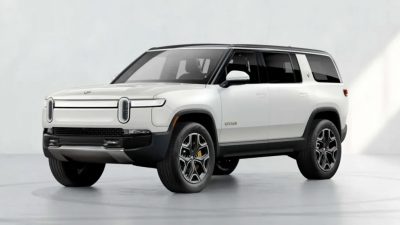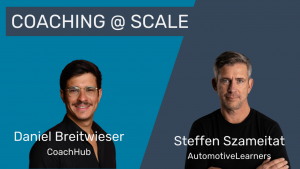Reading time: 8 minutes
For many, the transformation in the German automotive industry is going too slowly. On LinkedIn, German manufacturers and suppliers are criticized: too slow, too indecisive, and too complicated.
At this speed, will SMART MOBILITY ever hit the road?
Technical innovations in vehicles often come from suppliers. Accordingly, they have to invest a lot and take a lot of risks in product development. To get an inside view, I’m talking to Rosa Meckseper, Head of Business Area Smart Mobility, Continental North America. Previously, she was SVP Corporate Strategy at Continental and VP-Marketing and Business Strategy at Bosch Chassis Control Systems.
Steffen Szameitat: First of all, the introductory question: What is your dream car?
Rosa Meckseper: Dream car is classically associated with an Aston Martin DB 5 or Jaguar E Type from the 1960s. So emotionally charged, and such beautiful cars. However, the current cars with complete ADAS equipment are suitable for everyday use and are future oriented. Especially the cars from the west coast and those from the German manufacturers. Of course, these innovative technologies are extremely exciting for me
Steffen Szameitat: We are currently witnessing a wave of advancements in hardware, software, and sensor technologies, but there is also a sense of disappointment. In 2017 and 2018, there were also voices in Germany that we would be fully automated in 2022. That’s when disillusionment set in. Where is the journey going?
Rosa Meckseper: Software-defined vehicles are being developed much more from the user’s point of view. This results in new requirements, new user experiences that we are developing that require a change in the EE architecture. And thus, a completely different way of thinking, approach, than anything we’ve seen before, to reflect that in the vehicle. These visions, which are conceived by the customer, are broken down into individual applications. The implications for software and hardware requirements are, of course, enormous.
Steffen Szameitat: What does this mean for the car, what will we see on the road?
Rosa Meckseper: We are already witnessing a progressive, evolutionary development. The great, much-discussed topic is when we’ll achieve level five, which is driverless, completely automated driving in both cities and on highways. However, we are making progress in small steps.
Steffen Szameitat: We are currently witnessing a wave of advancements in hardware, software, and sensor technologies, but there is also a sense of disappointment. In 2017 and 2018, there were also voices in Germany that we would be fully automated in 2022. That’s when disillusionment set in. Where is the journey going?
Rosa Meckseper: Software-defined vehicles are being developed much more from the user’s point of view. This results in new requirements, new user experiences that we are developing that require a change in the EE architecture. And thus, a completely different way of thinking, approach, than anything we’ve seen before, to reflect that in the vehicle. These visions, which are conceived by the customer, are broken down into individual applications. The implications for software and hardware requirements are, of course, enormous.
Steffen Szameitat: What does this mean for the car, what will we see on the road?
Rosa Meckseper: We are already witnessing a progressive, evolutionary development. The great, much-discussed topic is when we’ll achieve level five, which is driverless, completely automated driving in both cities and on highways. However, we are making progress in small steps.
Steffen Szameitat: So, we’ll do it step by step from here. Manufacturers can no longer rely on large leaps; instead, the entire EE architecture, including hardware and sensors, must be updated, allowing different vehicle classes to be brought through, into the field, etc.
Rosa Meckseper: Exactly. At the same time, the sensors and hardware used in automatic driving or smart vehicles must be affordable. That is why there is currently a strong emphasis on defining standards for both hardware and software.
We need reusable, standardized components to reduce costs, scale, and allow speed in development, manufacturing, and updates later. It is not only the platform that is new, i.e., hardware and software, but also the development method.
In principle, we know from smartphones that we need to consider life cycles and be able to update software more quickly. In the car, however, things are far more complicated. This is where the safety criteria come into play, as it is all about the occupants’ safety in real time when driving becomes automated. Other essential components are cybersecurity and life cycle upgrades, which take effect instantly or run and interact with algorithms. Everything must be fully regulated and secured.
What you see on the market in a short time will not be a fully automatic car. You’ve seen that right. But we see evolutionary developments. And what’s going on behind the scenes is just enormous.
That is the shift we are currently going through. Here, we require all other points of view and methods of thinking. We must be more efficient, innovative, and minimize monolithic systems to make them smaller, more manageable, and modular. This is the current trend in automotive development.
Steffen Szameitat: Is the division of tasks between manufacturer and supplier shifting?
Rosa Meckseper: Totally. And if you asked me what I would write in a letter to the CEO or all of the CEOs if I had the opportunity, I would say that industry collaboration is the most important aspect of making the whole thing, this transition, happen. No single firm in the world will be able to accomplish this alone. We need distinct specialists and jobs. We need hope and teamwork to make the software-defined transition a reality.
Steffen Szameitat: What might that look like in concrete terms? Will the Germans then work together, or will the Germans work together with the Chinese, or will they all work together?
Rosa Meckseper: Everyone is responsible for making their own decisions. So, in my experience, intimacy is vital. In Germany, for example, there is a cluster in Stuttgart. This is already advantageous if the language and spatial closeness are also specified. At the end of the day, not only culture and teamwork are important, but competence is the driving force. There may be Japanese alongside Germans, as well as Japanese OEMs, suppliers, or new players alongside Americans. And we see various relationships in all special elements, as well as in bigger sectors.
Steffen Szameitat: Among other things, you are in charge of the aftermarket for Continental North America, which means you are particularly concerned with the supply of fleets with spare parts and spare parts components. Cars are becoming more complicated as software and sensors are integrated. What should we be prepared for on both the customer and store sides?
Rosa Meckseper: Like any technological development, it is initially offered in the OEM’s own workshops for more complicated repairs or new repairs, and then, after 3 to 5 years, depending on the penetration, it comes into the independent aftermarket. And that’s the area where we’re growing. We also support OEMs in their own aftermarket with products. The challenge will be to find qualified mechanics and master craftsmen. No matter who you ask in the industry, in the aftermarket, it’s been the main driver worldwide for a while now that we don’t get enough people in the workshops. And once we have them, it is of course a matter of training them step by step: for example, in sensor technology, i.e., the calibration of a replaced camera or a new radar.
Steffen Szameitat: Is this a strategic issue for you, and do you have any ideas for addressing the scarcity of competent car mechanics?
Rosa Meckseper: That is a good question. Above all, we bring the parts to the workshops. We have relatively few of our own workshop chains. We have our own workshops in Europe, including Best Drive and Vergölst. We feel something, but it is not our main attention. Remote Vehicle Diagnostic already relieves us of some of the burden. Replacing such a part on-site requires the staff to be present in the workshop.
Steffen Szameitat: When will the new software-defined vehicles arrive in the independent aftermarket?
Rosa Meckseper: They can already be found in the independent aftermarket. Because it is up to the driver to choose which training to attend. The only question is whether the workshop is qualified to accept the car. They frequently lack the confidence to do so.
Steffen Szameitat: Will this bottleneck become more apparent in ten years as the vehicle fleet’s adoption of new technology increases?
Rosa Meckseper: The bottleneck is the headcount in the workshops. And that’s already the case today. This has nothing to do with vehicle technology. The employees are still lacking today. This has to be solved one way or another.
Steffen Szameitat: Speaking of smart mobility, how will it develop in 10 years?
Rosa Meckseper: For us, Smart Mobility is a business area consisting of the aftermarket, commercial vehicle business, and telematics and services.
Smart is aftermarket because it is more environmentally friendly to fix a vehicle rather than replace it. Smart is the logistics division, where we collaborate with our partner Aurora on fully autonomous commercial trucks. And smart is, in a larger sense, a vehicle or offer that can think for itself and relieves the driver of tedious responsibilities. Which improves security. Which promotes sustainability and efficiency.
For example, we collaborate with Sona Telematics, a Seattle-based subsidiary, to create telematics solutions for school buses. With the answer, as a mother or father, you know exactly that my child has entered the car; where is it now? And even if it arrived safely at the school or at home.
Telematics solutions in every way contribute to what we call smart mobility.
Steffen Szameitat: That sounds pragmatic: “Let’s walk before we run.”. Take individual steps that can be implemented with technology, with sensors, and with software.
Rosa Meckseper: We take a very, very close look at the use cases before we decide what to do with whom.
But I understand the disillusionment. I feel the same way. I also participated in the strategy rounds roughly ten years ago. I also recall the large scenarios we painted: evolutionary and revolutionary at the same time.
In the end, nothing came of it. On the one hand, cost considerations: you cannot fund everything for the same yield. However, this is also due to the sheer complexity.
And it doesn’t work without collaboration. Partnerships do not just benefit from synergy in terms of competence. There are additional hazards on the cultural and collaborative levels. It is impossible to predict or influence the strategies of all parties in a relationship. This increases the overall complexity and difficulty on all levels.
That is why everyone in the sector today is evaluating developments on a case-by-case basis and deciding whether to play on all issues or just a few. And if so, what ones?
Steffen Szameitat: The automotive industry exhibits unique innovation cycles. The comparison to cellphones or computer technology is deceiving, as software development cycles are significantly faster, and capacity increases exponentially, according to Moore’s Law. However, after so much investment, we’ve discovered that the notion that the more we move the automobile in the direction of the computer, the faster it accelerates, is not always correct.
Rosa Meckseper: Yes, a vehicle has completely different requirements than a smartphone in terms of real-time, security, cybersecurity, and, of course, costs. This creates a new dimension of complexity. The smartphone is a good analogy, and you can learn a lot from it and be an inspiration. But it’s not the same.
Incremental innovation, case-by-case decisions, and partnerships are ways to move forward.
Steffen Szameitat: Great summary. Thank you, Rosa, for the interview.




